Guy Reynolds
This lecture begins, in fact, with images not words: footage from Peter Jackson’s recent, restored First World War documentary, ‘They Shall Not Grow Old.’ Watching these artillery pieces, these early tanks and the sheer machine-like movement of troops across Western Front, we see one of the creative origins of the century’s British fiction.
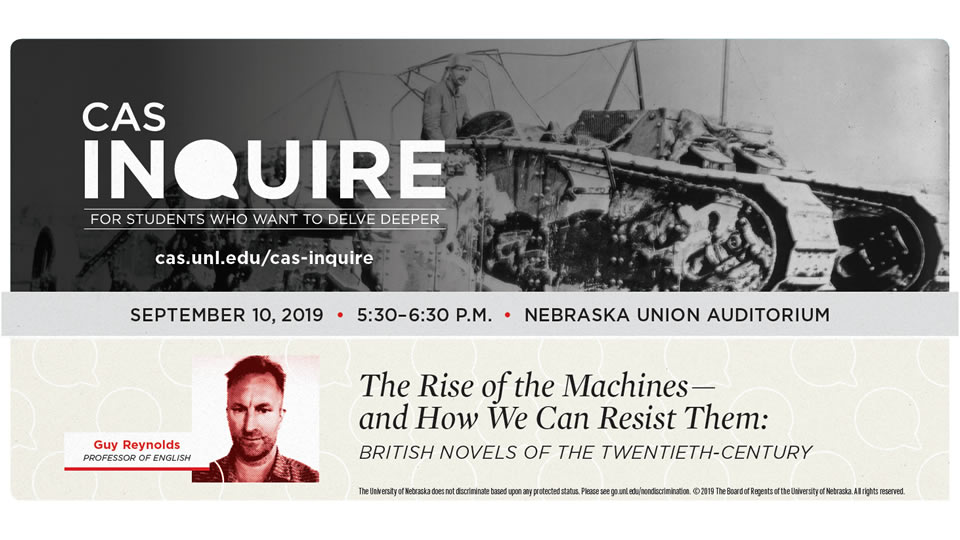
The talk locates the ‘rise of the machines,’ as far as many writers have been concerned, in the late nineteenth-century advent of second-wave industrialism, and the technologized war that then ensued. It examines four writers (Orwell, Huxley, Tolkien, Burgess) who all reacted, with fascination and horror, to the vortex of technology and destruction that had brought a ghastly halt to the benign technological progressivism of the nineteenth-century.
Reynolds argues that these experiences created, if you like, a kind of new collective unconsciousness for these writers (and many others) – forged out of historical circumstance, but now almost mythical in its suggestiveness. The seduction of the machine; the machine’s apocalyptic power; and then the exploitation of technology through systems of control – these would become the key elements of a quasi-allegorical fiction that often veered between utopia and dystopia, as the writer sensed the liberation of technology, and also its destructive possibilities.
The lecture touches on many novels that undergraduates will be familiar with, but then places them in this new context. The Lord of the Rings, Brave New World, 1984, A Clockwork Orange: the talk traces a kind of counter-history through these texts. Reynolds examine the various ‘machines’ that sit at the center of each of these novels: Sauron’s crazed world of heavy machinery and industrial domination; Huxley’s fascination with a biological re-engineering of society; 1984’s remarkable forecasting of an invasive information society; Burgess’s interest in how a fragile selfhood might be brutally re-modelled by psycho-medical conditioning. Throughout, Reynolds also draws on visual materials to animate and develops his argument (there are interesting film adaptations of all these works, and he read Kubrick’s A Clockwork Orange as a text in its own right).
Ultimately, the story moves from being one about technology, and how the writer responds to radical innovations such as the telescreen (in 1984) or the medicalized reprogramming of the human (A Clockwork Orange), to questions of politics and what would become known as bio-politics. Who will control these machines? How might they be exploited? Will they create new systems of power? Ultimately, all of these novels ask us to think about how authority interacts with, and is reshaped by, new modes of technology. Reynolds hopes that the lecture, tracking connections between literary culture, the history of technology, and fundamental political questions, will be both interdisciplinary and suggestive.
Carrick Detweiler
Unmanned Aerial System (UASs), also known as drones, gained fame as machines of war operating in the Middle East. But now, drones have become inexpensive consumer products with millions sold each year.
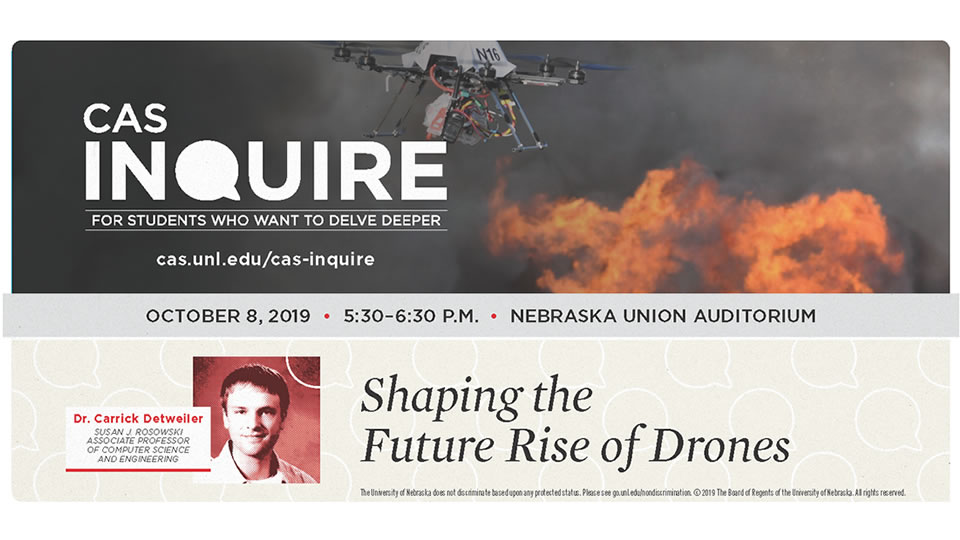
While drones certainly did not start the Rise of the Machines, they are contributing to it. Now consumers can purchase drones that can automatically follow them and take selfies from the air. Beyond being simple toys, however, drones are increasingly used for everything from surveying crops for stressed plants to inspecting roofs for hail damage. Drones are significantly cheaper and safer than traditional manned airplane or helicopter approaches to obtaining aerial imagery and sensor data.
The next generation of UASs, however, will do more than simply taking pictures from the air.
In this talk, Detweiler will discuss the developments of the past 20 years that made drones possible and then will present future drones that will closely interact with people and the environment. At the University of Nebraska's Nimbus Lab, we are developing the next generation of drones that are doing things like collecting water samples, digging holes in the ground to install sensors, and starting fires from the air to support prescribed fires. These require advances in everything from the electro-mechanical design to novel software that can automatically detect faults to reduce risk and increase safety. By leveraging these advances, we can shape the Rise of the Machines to benefit society.
Colin Meiklejohn
A cult of DNA pervades our society, promising to unlock health, personality, and genealogy through the reading and interpretation of our genomes. This cult is fueled by warehouses across the world filled with robotic sequencing machines and supercomputers that interpret their output, relentlessly harvesting trillions of base-pairs of DNA sequence data per hour.
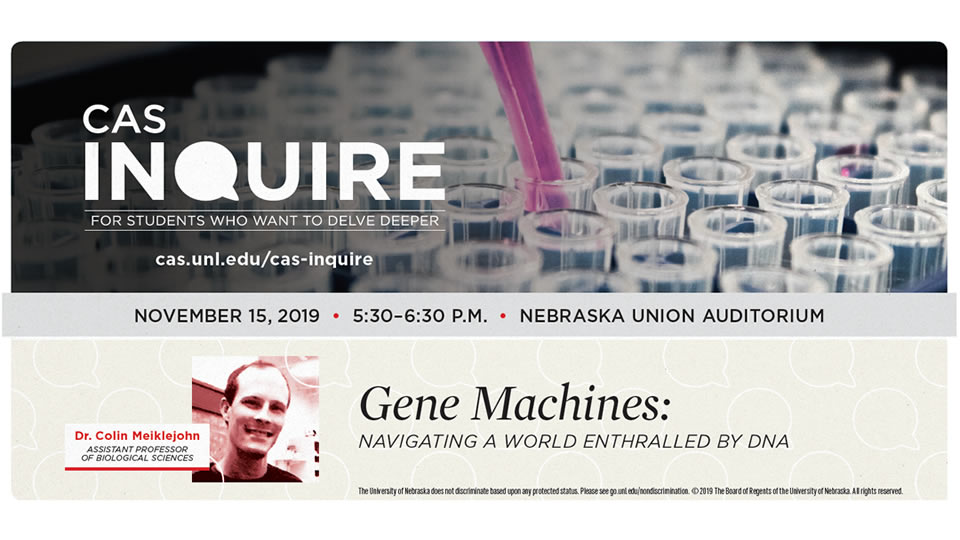
How can we as a society grapple with this cult of genetic determinism, and the corporations and misanthropists that exploit its tenets for their own profits and divisive ends?
Advances in biology, chemistry, optics, robotics, microfluidics and nano-manufacturing have reduced DNA sequencing costs 100,000-fold in the past two decades. Handheld sequencing devices connected to a laptop sequence 20 billion base-pairs per day. To sequence a million base-pairs from an individual costs less than ten dollars. The world is drowning in a flood of DNA sequence data.
We are told these technologies bring a revolution to medicine and the stories of our past. Precision medicine promises to better predict disease, optimize drug treatment, counsel lifestyle choices. This knowledge is gleaned from correlating DNA sequences with medical data from millions of humans. Cheap DNA sequencing has birthed direct-to-consumer genetic testing companies that have amassed their own databases of genetic data from millions of customers. Through these databases, customers can locate relatives, find the geographic habitat of their ancestors, and discover if they carry genetic variants enriched among elite athletes or people with high cholesterol. Other genetic databases have been used to crack decades-old unsolved crimes through forensic matching. We have sequenced DNA from the bones of hundreds of individuals who lived from 5,000 to 430,000 years ago. These ancient samples are confirming and overturning the stories of our pre-history. The revolution in DNA sequencing technology lays claim to reveal who we are as individuals, and how we got here as a species.
But what if these claims are oversold, overhyped, and uncritically accepted by the public? Snake oil has always been profitable; there is a strong financial incentive to overstate and oversimplify the role of DNA in shaping our bodies and minds. Widespread public acceptance of genetic determinism lends a veneer of science to racist and eugenic doctrines that misuse genetic inferences to support these odious ideologies. It seems worth considering the downsides of sequestering the most intimate genetic details of millions of people on the servers of large multinational corporations. Do individuals have the right to keep their genome sequence unknown to others? Or is it a commodity to be sold alongside your Facebook profile to the highest bidder? Insurance companies have already started requiring biometric data for policies, and will no doubt find genetic variants with effect sizes large enough to tweak premiums. And of course, servers are hacked; data is stolen.
The machines that read and interpret our genetic essence and the cult they feed are already with us today. An educated and rational public is required to distinguish real scientific advances from hype and lies, and to ensure these advances redound to the benefit of all people.
Christian Binek
Nanotechnology has been envisioned by Nobel laureate Richard P. Feynman in his celebrated 1959 Caltech talk entitled “There’s plenty of room at the bottom”. He famously raised the question “What would happen if we could arrange the atoms one by one the way we want them?” Today we came very close to fulfill Feynman’s vision through technological capabilities allowing to image and manipulate structures at the nanoscale.
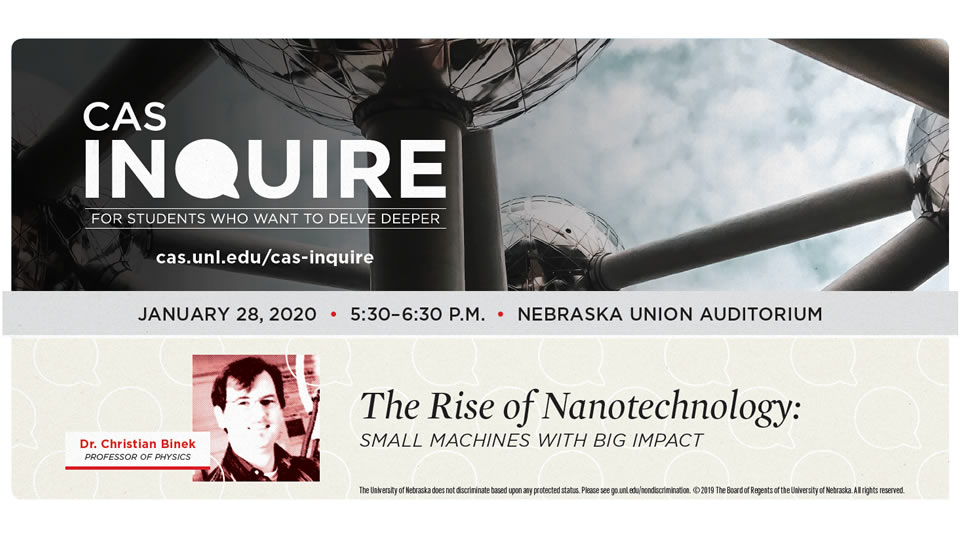
The disruptive consequences of these achievements become apparent when realizing that all physical properties of matter are determined by the underlying atomic structure which now can be manipulated almost at will limited only by our imagination and the constraints determined by the fundamental laws of quantum physics.
In the lecture Binek will give a brief introduction to the length and time scales associated with nanoscopic phenomena. He introduces the concept of emerging interface phenomena, highlights the significance of quantum mechanics in the nanorealm, and gives a brief overview on modern tools of nanotechnology with emphasis on those available at the University of Nebraska-Lincoln.
On this basis Binek will move on to present examples of state-of-the-art nanostructures and nanotechnologies. He highlights the interdisciplinary aspect of nanotechnology and shows how interdisciplinarity can lead to accelerating progress. Examples are the role of diffraction physics for advances in molecular biology including the discovery of the double helix structure of the DNA and the role of materials science for the next generation of information technological devices. Special emphasis will be on the interplay between fundamental science and technology.
Binek concludes with an attempt to extrapolate toward future developments including Feynman’s dream of “swallowing the doctor”, the predicted transformative power of nanotechnology in information technology, medical applications, energy, water supply, smart materials and manufacturing and the nanotechnological merger of all these fields. While the internet of things, which makes nanotechnology an integral part of objects surrounding us, is already emerging, future advances in nanotechnology may very well give non-biological objects properties associated today with biological entities. Moreover, nanotechnology may become an integral part of human existence. We will come to the conclusion that in all areas affected by nanotechnology radical transformations take place beyond our linear intuition.
Carrie Heitman and Heather Richards-Rissetto
As we contemplate the “Rise of the Machine”, let us pause to more critically consider the black box technologies embedded within our daily human-computer interactions. In recent years there has been a growing awareness of the implicit and explicit biases embedded in the technologies we use.
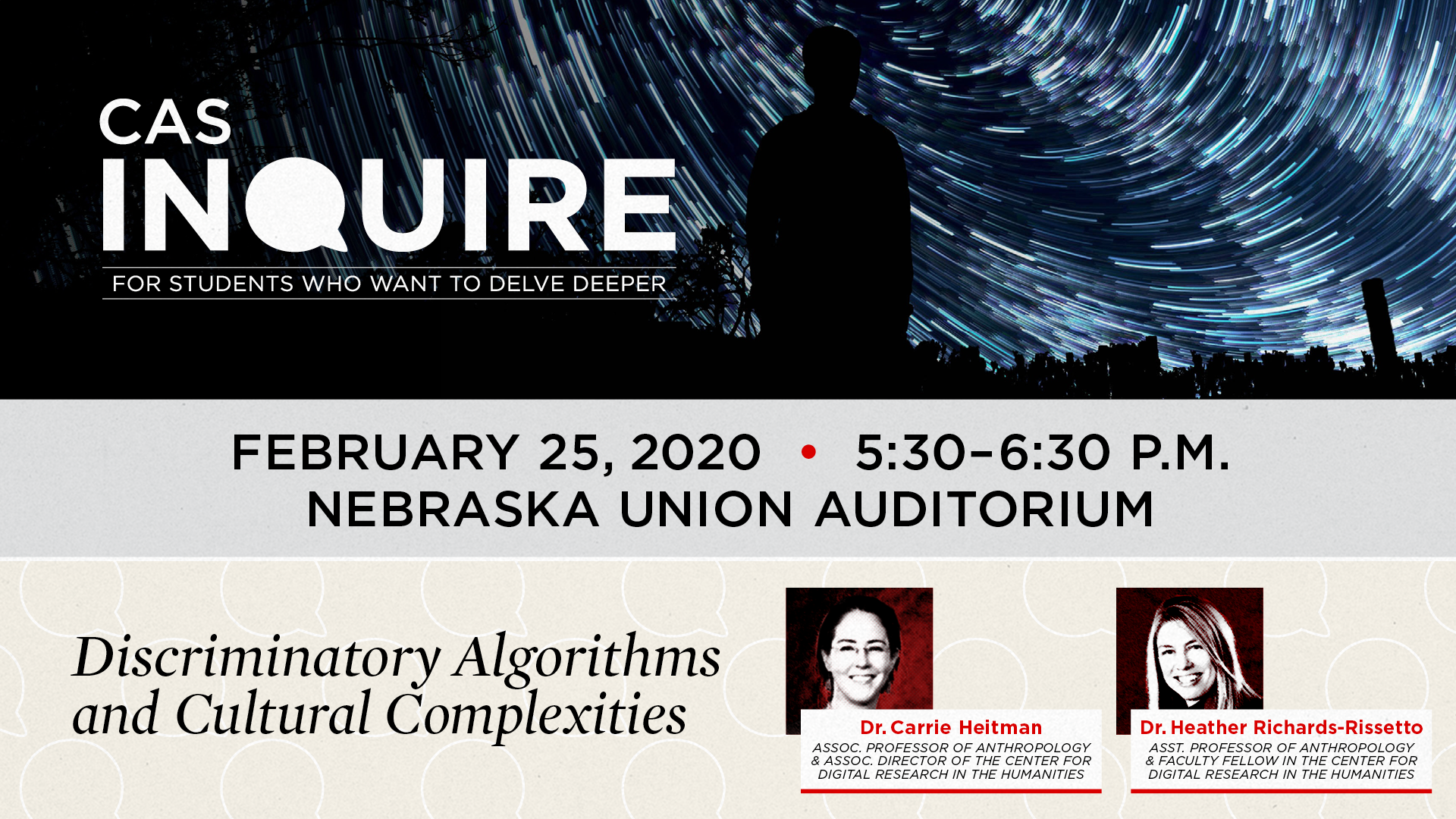
In some cases, image pattern recognition algorithms reveal the racial biases of their developers.
In 2018 Google Photos image recognition algorithms, for instance, were classifying dark-skinned faces as “gorillas.” HP computers could identify and track white faces, but not dark skin tones. When analyzing images of Asian faces, Nikon cameras were asking if someone blinked.
Algorithmic biases are also at work within our respective social media “feeds”—resulting in our much-maligned like-minded echo chambers. Language translators and speech recognition software often have gender biases. But the political, social, ethical and economic risks associated with algorithmic logic of machine learning are greater still.
Take for instance the AI COMPAS algorithm widely used in the US to guide sentencing by predicting the likelihood of a criminal reoffending. In perhaps the most notorious case of AI prejudice, in May 2016 the U.S. news organization ProPublica reported that COMPAS is racially biased.
In this presentation, anthropologists Richards-Rissetto and Heitman will talk about the power and peril of computational algorithms—discussing what they are, how they work, what they enable us to do as researchers, and the risks that come with them.